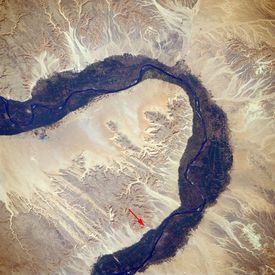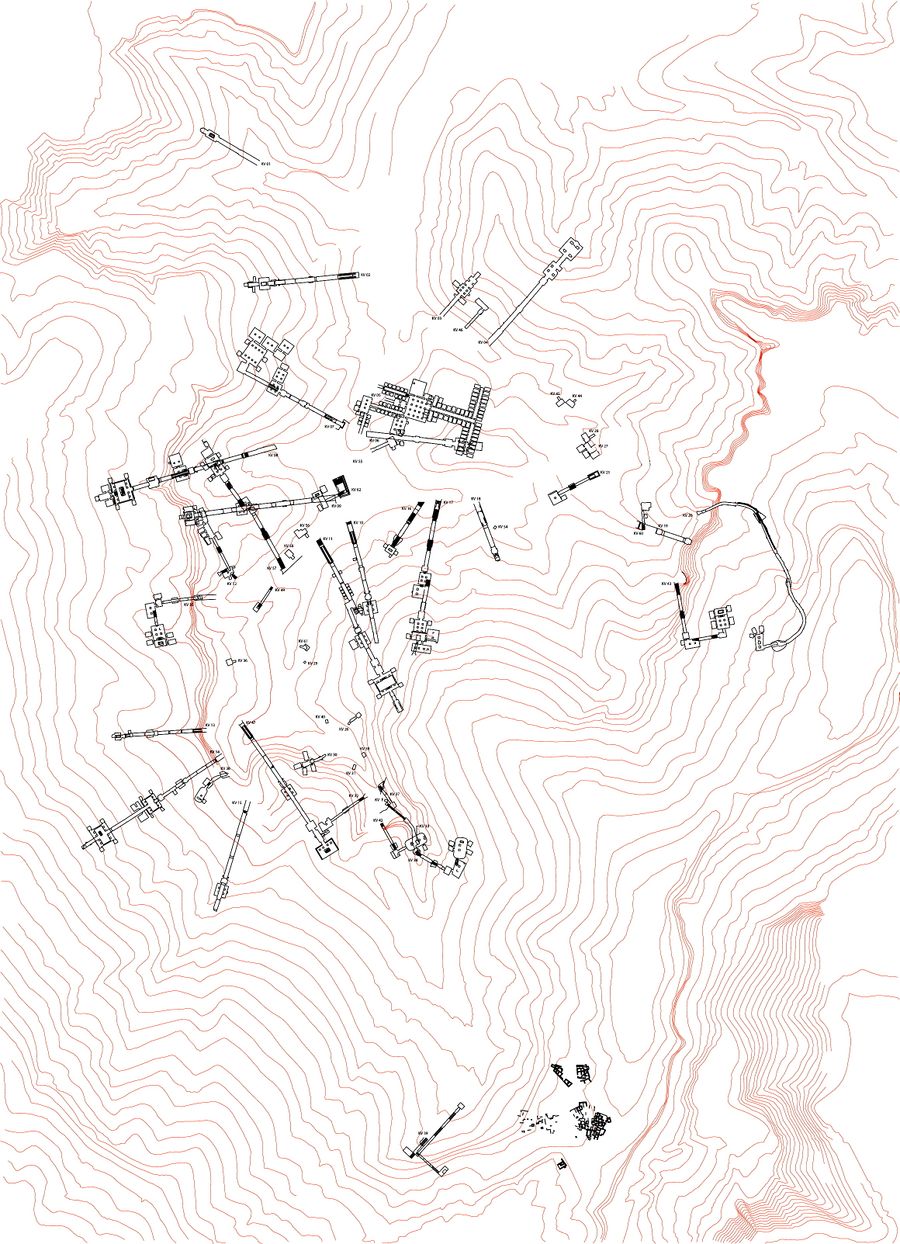მეფეთა ველი
მეფეთა ველი (არაბ. وادي الملوك, Wādī al Mulūk), მეფეთა კარიბჭის ველი (არაბ. وادي ابواب الملوك, Wādī Abwāb al Mulūk), არის ველი ეგვიპტეში, სადაც 500 წლის განმავლობაში, ძვ. წ-აღ. მე-16 საუკუნიდან ძვ. წ-აღ. მე-11 საუკუნემდე ფარაონებისა და ეგვიპტელი დიდებულებისათვის გამართული იყო დასაკრძალი აკლდამები ძველი ეგვიპტის ახალი სამეფოს ხანაში (ძველი ეგვიპტის მე-18 — მე-20 დინასტიები).
ველი მდებარეობს მდინარე ნილოსის დასავლეთ ნაპირზე, ძველეგვიპტური ქალაქის თებეს (თანამედროვე ლუქსორი) საპირისპირო მხარეს, თებეს ნეკროპოლისის შუაგულში. ვადი შედგება ორი ველისაგან: აღმოსავლეთ ველისა (სადაც თავმოყრილია სამეფო აკლდამების უმეტესობა) და დასავლეთ ველისაგან.
2005 წელს ახალი აკლდამის KV63-სა და 2008 წელს კიდევ ორი ახალი აკლდამის ჩასასვლელის აღმოჩენის შემდეგ ველზე გამოვლენილი სამარხებისა და აკლდამების რიცხვი 63-ს მიაღწია (სადაც წარმოდგენილია როგორც უბრალო ორმოსამარხები (მაგ. KV54), ასევე დიდი კომპლექსები (როგორიცაა მაგ. KV5, რომელიც 120 სამარხისგან შედგება). ეს იყო ახალი სამეფოს ფარაონებისა და დიდებულების მთავარი დასაკრძალი ადგილი. სამეფო აკლდამები შემკულია სცენებით ეგვიპტური მითოლოგიიდან და წარმოდგენას გვიქმნის მაშინდელი რწმენისა და დაკრძალვის ტრადიციების შესახებ. თითქმის ყველა აკლდამა გახსნილი და გაძარცულია ძველ დროს, მაგრამ ისინი მაინც გვიქმნის წარმოდგენას ფარაონების სიმდიდრისა და ძალაუფლების შესახებ.
ეს მიდამოები არქეოლოგებისა და ეგვიპტოლოგების შესწავლის ინტერესს მე-19 საუკუნის ბოლოდან წარმოადგენს და სულ ახალი და ახალი აღმოჩენები კვლავ აღრმავებს მეცნიერთა ინტერესს. ბოლო დროის უდიდესი აღმოჩენა იყო ტუტანხამონის KV62 აკლდამის აღმოჩენა, რომელიც მსოფლიოს ერთ-ერთ უდიდეს არქეოლოგიურ აღმოჩენად ითვლება. 1979 წელს ის თებეს ნეკროპოლისთან ერთად, იუნესკოს მსოფლიო მემკვიდრეობის ძეგლად გამოცხადდა.
| |
აღმოსავლეთი ველი
Most of the open tombs in the Valley of the Kings are located in the East Valley, and this is where most tourists can be found.
| Number | Name | Time Period | Comments |
|---|---|---|---|
| KV1 | Ramesses VII | 20th dynasty | |
| KV2 | Ramesses IV | 20th dynasty | |
| KV3 | Unnamed son of Ramesses III | 20th dynasty | |
| KV4 | Ramesses XI | 20th dynasty | |
| KV5 | Sons of Ramesses II | 19th dynasty | With 120 known rooms and excavation work still underway, it is probably the largest tomb in the valley. |
| KV6 | Ramesses IX | 20th dynasty | |
| KV7 | Ramesses II | 19th dynasty | |
| KV8 | Merenptah | 19th dynasty | |
| KV9 | Ramesses V and Ramesses VI | 20th dynasty | Also known as the Tomb of Memnon or La Tombe de la Métempsychose. |
| KV10 | Amenmesse | 20th dynasty | |
| KV11 | Ramesses III | 20th dynasty | Also referred to as Bruce's Tomb, The Harper's Tomb. |
| KV12 | Unknown | 18th and 19th dynasty | It was possibly used as a family tomb. |
| KV13 | Bay. Later Amenherkhepshef and Mentuherkhepshef | 19th and 20th dynasty | |
| KV14 | Twosret, later reused by Setnakhte | 19th and 20th dynasty | |
| KV15 | Seti II | 19th dynasty | |
| KV16 | Ramesses I | 19th dynasty | |
| KV17 | Seti I | 19th dynasty | Also known as Belzoni's tomb, the tomb of Apis, or the tomb of Psammis, son of Necho. |
| KV18 | Ramesses X | 20th dynasty | |
| KV19 | Mentuherkhepshef | 20th dynasty | |
| KV20 | Thutmose I and Hatshepsut | 18th dynasty | |
| KV21, KV26, KV27, KV28, KV29, KV31, KV33, KV37, KV44, KV59 | Unknown | New Kingdom | The original owners of these tombs are unknown. |
| KV30 | Unknown | 20th dynasty | Known as Lord Belmore's tomb. |
| KV32 | Tia'a | 18th dynasty | |
| KV34 | Thutmose III | 18th dynasty | |
| KV35 | Amenhotep II | 18th dynasty | Over a dozen mummies, many of them royal, were relocated here (see list). |
| KV36 | Maiherpri | 18th dynasty | A noble from the time of Hatshepsut |
| KV38 | Thutmose I | 18th dynasty | Probably prepared for this king by Thutmose III. |
| KV39 | Possibly the tomb of Amenhotep I | 18th dynasty | |
| KV40 | Tomb of King's Daughters and Sons | 18th dynasty | Burials date to the time of Amenhotep III. Later intrusive burials from the 22nd Dynasty are also present.[1] |
| KV41 | Unknown | 18th dynasty | The tomb may have been Queen Tetisheri? |
| KV42 | Queen Hatshepsut-Meryetre | 18th dynasty | |
| KV43 | Thutmose IV | 18th dynasty | |
| KV45 | Userhet | 18th dynasty | Tomb of a noble |
| KV46 | Yuya and Tjuyu | 18th dynasty | The parents of Queen Tiy. Until the discovery of the tomb of Tutankhamun, this was the best preserved tomb to be found in the Valley. |
| KV47 | Siptah | 19th dynasty | |
| KV48 | Amenemopet called Pairy | 18th dynasty | Tomb of a noble. |
| KV49 | Unknown | 18th dynasty | Tomb was possibly a store room. |
| KV50,KV51, KV52 | Unknown | 18th dynasty | Tombs contain animal burials, which were possibly the pets of Amenhotep II, whose tomb is nearby. |
| KV53 | Unknown | New Kingdom | |
| KV54 | Unknown | 18th dynasty | This was probably an embalming cache for the tomb of Tutankhamun. |
| KV55 | Smenkhkare/Akhenaten | 18th dynasty | This tomb might be another mummy cache, and once possibly contained the burials of several Amarna Period royals –Tiy and Smenkhkare/Akhenaten. |
| KV56 | Unknown | 19th dynasty | Known as the Gold Tomb, the original owner of this tomb is unknown. Items with names of Ramesses II, Seti II and Tawosret were found. |
| KV57 | Horemheb | 18th dynasty | |
| KV58 | Unknown | 18th dynasty | Known as Chariot Tomb, the original owner of this tomb remains unknown. Gold foil contains names of Tutankhamen and Ay |
| KV60 | Sitre In | 18th dynasty | Royal nurse of Hatshepsut |
| KV61 | Unknown | New Kingdom | This tomb appears to have been unused. |
| KV62 | Tutankhamen | 18th dynasty | Perhaps the most famous discovery of modern Western archaeology was made here by Howard Carter on November 4, 1922, with clearance and conservation work continuing until 1932. Tutankhamun's tomb was the first royal tomb to be discovered that was still largely intact (although tomb robbers had entered it), and was for many years the last major discovery in the valley. The opulence of his grave goods notwithstanding, King Tutankhamun was a rather minor king and other burials probably had more numerous treasures. Some members of the archaeological teams led by Carter and later archaeologists contracted local lethal viruses through food or animals (particularly insects), resulting in the infamous "Curse of the Pharaohs" modern legend. |
| KV63 | Unknown | 18th dynasty | The purpose of this tomb is currently unknown. |
| KV64 | Singer [the Lady] Nehmes Bastet | 18th and 22nd dynasty | An unexcavated tomb entrance, discovered in July 2008[2] The tomb was later excavated and was shown to have been used in the 18th as well as in the 22nd dynasty. The Lady Nehmesbastet lived during the 22nd dynasty.[3] |
| KV65 | Unknown | New Kingdom | An unexcavated tomb entrance, discovered in July 2008[2] |
| KVB – KVT | Unknown | New Kingdom | These are non-burial pits, some of which may have been intended as tombs, others were probably funerary deposits. |
დასავლეთი ველი
The numbering the West Valley follows in sequence to that of the East Valley, and there are only four known burials / pits in the valley.
WV22 – This is the tomb of one of the greatest rulers of the Egyptian New Kingdom, Amenhotep III. It has recently been investigated, but is not open to the public.
WV23 – This is the tomb of Ay and is the only tomb that is open to the public in the West Valley.
WV24 – The original owner of this tomb is unknown.
WV25 – This tomb may have been started as the Theban burial of Akhenaten, but it was never finished.
WVA – This was a storage chamber for Amenhotep III's tomb which was located nearby.- ↑ Susanne Bickel, Princesses, Robbers and Priests - The unknown side of the Kings' Valley, Presentation at a conference at the Museo Egizio in Turin, Italy, October 14 2017, Online; KV 64 discussed at 40:00 onwards
- ↑ 2.0 2.1 თარგი:Cite web
- ↑ Susanne Bickel, Princesses, Robbers and Priests - The unknown side of the Kings' Valley, Presentation at a conference at the Museo Egizio in Turin, Italy, October 14 2017




